
|
A Parent's Guide to Preventing Homosexuality , by Joseph Nicolosi, Ph.D., and Linda Ames Nicolosi, Intervarsity Press, 2002, 6"x9" softcover, 254 pages, with endnotes, no index
I must be a masochist, or a philosopher of illogic, because I actually enjoy parsing the desperately perverted reasons that anti-gay individuals use to justify their disgust with homosexuality. Nicolosi's book will not disappoint students of demagoguery. He manages to subtly weave the inflammatory topics of ex-gays, sissy boys, homosexual pedophilic child abuse, HIV/AIDS, anal sex and the harm of the homosexual lifestyle all into one G-rated book. It is unfortunate that this book will succeed in inciting the fear of homosexuality in many parents with gay children. Preventing Homosexuality is the same book that setoff a major controversy with its advertisement in the December 2002 issue of Psychology Today. The editor-in-chief Dr. Robert Epstein defended the book in Gay Today and other publications by citing an American Psychological Association professional journal paper, out of context from other articles in the same issue that documented the harm of unethical ex-gay therapy. Epstein, in multiple email responses, would not condemn unethical ex-gay therapies as defined by a 1997 APA resolution that was published in the same journal. Instead, he claims to be a victim of intolerant and "angry" gay activists who are hypocritical for wanting to "deny" therapy to those who want to live as heterosexuals. Fox News Channel TV host Bill O'Reilly, who supports gay adoption but criticizes gays for flaunting their lifestyle, hosted a sound bite debate between Joseph Nicolosi and "gay activist" John Aravosis. O'Reilly cast Nicolosi as being a victim of attempted censorship by "angry" gay activists. O'Reilly ignored the ethical issue of promoting a book that advocates harmful child abuse because "no parent would want their child to be homosexual."
The book barely mentions the fact that virtually all "successful" ex-gays say they were motivated by religion. Apparently for religious reasons, some ex-gays are happy, as are celibate priests, to deny their sexual attractions, which even Nicolosi agrees are retained after therapy. Nicolosi does not say how many people, either straight or gay, would be happy to deny their sexual urges. This number would probably predict a dismal outcome for his therapy. Nicolosi enables the parents of boys, who are his typical clients, to decouple from conflicting religious beliefs and to make a decision based on the "religion" of science and medicine. Nicolosi's pseudo-scientific language is designed to overcome the parents' reluctance to reject their boy's sissy behavior. Most parents will defer to medical authority because they assume that doctors "know" more than they do. Parents also accept that bad tasting medicine is sometimes required to get well. Few of Nicolosi's clients are girls because he says tomboys are "less of a problem." He devotes only one chapter to preventing lesbianism. His focus is clearly on sissy boys and he hopes that another therapist will write a book for ex-lesbians. The included transcripts of therapy sessions with parents seem to be carefully chosen to avoid any appearance of child abuse. Before seeking therapy, most of the parents were tolerant of their boy's gender behavior, which Nicolosi thinks is the problem because it leads to homosexual development. Many of the parents seemed to want therapy to help their boys deal with the harassment that comes with being different rather than therapy to change gender behavior as Nicolosi prescribes. To Nicolosi's credit he acknowledges the legal scholars who have suggested that forcing an effeminate boy into acting like a "real boy" may constitute child abuse. To counter any accusations of child abuse, Nicolosi included occasional admonitions, such as the following: "Guilt, manipulation, force, or coercion will not free the client from his attractions but will only cause greater alienation." (p. 142) "If the adolescent is resistant to participating in a reparative treatment program, and his cooperation is simply not forthcoming, then he should not be forced to participate. Even if your teenager decides to pursue therapy, there should be an open door policy, that is, he can leave at any time he chooses." (p. 145) "I had to intervene to tell these parents to back off. In their enthusiasm to change the feminine behaviors, they were going overboard in ways that would hurt the parent child relationship." (p. 223) "It's true that the struggle to develop one's heterosexual potential will, for some people, be a long and difficult one. And it's also true that your ongoing, loving relationship with your son must never be sacrificed." (p. 237) "And he may, if parental intervention is too harsh, go into withdrawal and isolation, becoming emotionally detached from the rest of the family." (p. 82)
Furthermore, some people are naturally fat or gay and trying to change them beyond a certain point is medically harmful. Nicolosi concedes that a boy may be fat or a sissy partially due to genetics, but he says that this is irrelevant because it is not "what ought to be" and the potential harm of the homosexual lifestyle justify the risks of ex-gay therapy. The "what ought to be" reason is based on Nicolosi's belief that "nature designed only men and women to fit together sexually." This is fundamentally a moral argument in disguise because "what ought to be" is defined by religion and culture rather than reason. Nicolosi, who scrupulously avoids using sexually graphic terms, infers that anal sex is unnatural because a penis doesn't "fit" in another man's ass or mouth. He indirectly compares gay sex to drinking through a straw stuck up the nose and asks if there is some "natural wisdom evident in our bodies' opposite-sex construction and the 'perfect fit' nature provided for heterosexual coupling?" Hopefully, Nicolosi will never need a proctoscope ultrasound exam because the instrument will clearly not fit in his ass. Nicolosi's believes most people have a "visceral reaction" to homosexuality of "shock and disgust." Like many anti-gay tracts, anal sex is used to fuel this reaction on at least ten pages in the book. For example, Nicolosi reveals that public schools are using a Gay Men's Health Crisis safe-sex pamphlet that he says, "describes 'safe' ways of dealing with grotesque, unnatural, and unhygienic sexual practices." Ironically, this would describe heterosexual sex equally well. I'm old enough to recall the "what ought to be" argument used to require every child to be right handed. I remember left-handed children being disciplined for using the hand of the devil by religious schoolteachers. Fortunately, left-handed kids are now accepted as being "born that way." My grandparents also assured me that fat people were considered rich, healthy and jolly back in their day. Notice how Santa Claus is traditionally depicted as being fat and jolly. Also, rich "fat cats." Both cultural and medical definitions of "what ought to be" change over time. The "what ought to be" argument also says that human design and purpose is to reproduce, but celibate priests go against this. Nicolosi resolves this by declaring that "normal functions" can be "sacrificed for a higher purpose." Similarly, he notes that "normal functions" can be expanded, such as using a calculator to augment your ability to do calculations, provided it doesn't "subvert the original created purpose," as presumably anal sex does. Nicolosi's "what ought to be" argument is so weak that he is forced to place greater emphasis on the potential harm of the homosexual lifestyle. The linkage between being gay and the harm due to pedophilic child abuse and anal sex leading to an HIV/AIDS death is mentioned on at least forty pages in the book. Nicolosi incorrectly quotes the highly respected 1994 Laumann sex survey to say "molestation triples the likelihood of self-identifying as gay or lesbian." Laumann clearly states that their data does not prove this. Actually, the Laumann data only shows that out of 1161 men who were not touched sexually as a child, 23 were gay men, whereas out of 145 men who were touched sexually as a child, 11 were gay men. All of these 145 men, both straight and gay, reported more difficulties with sex and a higher level of sexual activity than the other 1161 men. Their data more often correlates with many other, more serious, sexual difficulties than with just being straight or gay.
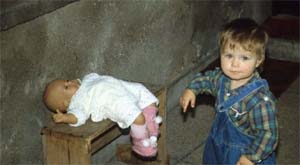 Nicolosi also incorrectly says sissy behavior leads to
homosexual development because 75% of sissy boys will grow
up to be gay according to the 1987 book, The Sissy Boy
Syndrome, by Richard Green. Buried in an endnote, Nicolosi
admits that Green disagrees with him on the "disordered
nature of the homosexual condition." Once again, this
correlation may be true, but it doesn't prove that forcing
a boy to be masculine will make him straight.
Nicolosi also incorrectly says sissy behavior leads to
homosexual development because 75% of sissy boys will grow
up to be gay according to the 1987 book, The Sissy Boy
Syndrome, by Richard Green. Buried in an endnote, Nicolosi
admits that Green disagrees with him on the "disordered
nature of the homosexual condition." Once again, this
correlation may be true, but it doesn't prove that forcing
a boy to be masculine will make him straight.
Nonetheless, Nicolosi instructs parents to modify their sissy boy's behavior by correcting him with the phrase, "That's a girl's behavior, but you're a boy!" (p. 110) Nicolsoi uses the "75% fact" to warn parents that gender-atypical behavior is a medical emergency because of the medically harmful homosexual lifestyle. He says to one parent, "If we don't make decisive interventions, your son will not have a normal gender identity and will probably become a homosexual." (p. 66) Elsewhere, Nicolosi contradictorily states, "First one must remember that most (italics in original) boys who become homosexual were never obviously feminine. The effeminate boy is an exaggerated case of the general syndrome of gender nonconformity that leads to homosexuality." (p. 44) Nicolosi believes that mental health professionals are remiss in not warning parents that their sissy boy has a 75% chance of becoming homosexual. But he contradictorily criticizes them for telling parent's that sexual orientation may be predetermined. I think most uninitiated parents would misinterpret the 75% number as meaning it is predetermined that their boy is gay, which would mislead them into accepting Nicolosi's bogus ex-gay therapy. Similarly, Nicolosi condemns mental health professionals for not warning about the medical risks of being homosexual. But hypocritically, he never once mentions the potential harm of ex-gay therapy that has been documented in many of the journals he cites. "Preventing homosexuality" is a misnomer for "preventing atypical gender behavior." I suspect that Nicolosi focuses on gender behavior because short-term results are easy to achieve. Even the most masculine of heterosexual men can modify their gender behavior, at least for a short period of time. He is also guaranteed a 25% success rate with sissy boys because this portion will naturally grow up to be heterosexuals. To avoid promising parents any long-term results, Nicolosi conveniently notes, "it will be one or two decades after treatment before a child's sexual orientation can be known." (p. 197) The alleged problem of atypical gender behavior is introduced on the very first page of the book. A quote from an ex-gay client blames his mother for making him gay by allowing him to play with Barbie dolls. I broke out laughing when I read this because I was denied the privilege of playing with Barbie dolls! My father finally relented and bought me a Ken doll when they were first introduced. Amusingly, after I had lost my interest in dolls, "gender-appropriate" G.I. Joe dolls were introduced for boys, which duplicated the design features that made Barbie so successful. I still have my original Ken doll, dressed up in his sexy underwear, standing next to my Billy doll. I seriously doubt that playing with dolls made me gay, but I may have made Ken gay because he is now a forty-year-old bachelor.
Perhaps not coincidentally, the psychiatrist's Diagnostic and Statistical Manual of Mental Disorders (DSM) mentions boys playing with "Barbie" as a diagnostic example of "Gender Identity Disorder (GID)." However, the DSM criteria for this disorder clearly exclude homosexuals and those who are not distressed or disabled by their sissy behavior. Of course, much of the distress from sissy behavior is caused by society's rigidly dualistic view of gender. Nicolosi emphasizes that this distress is not the fault of society if a boy "chooses" to act like a girl. Gay people know from personal experience that gender identity and sexual identity can be found in any combination. The most rare combination documented in the DSM appears to be gay female-to-male (FTM) individuals who were born women but act like men and are sexually attracted to men. Yet Nicolosi insists on intermixing sexual orientation with gender. The DSM diagnostic categories are important because they must be used to bill most medical insurance plans and they are essential for maintaining consistency between controlled research studies. Nicolosi is one of a few ex-gay therapists who fraudulently misuse "Gender Identity Disorder" for treating homosexuality. Other ex-gay therapists misuse the diagnoses "Sexual Disorder Not Otherwise Specified" or "Identity Problem," because the current revision of the DSM mentions sexual orientation in both of them. Previous versions of the DSM, which were published after homosexuality was removed as a mental disorder in 1973, retained an "ego-dystonic homosexuality" category for homosexuals who were "distressed" and wanted to be heterosexual. When this category was removed in 1987, ex-gay therapists, such as Nicolosi, begrudgingly changed their clients' diagnosis to other categories. Nicolosi goes one step beyond the DSM when he defines homosexuality as a "developmental disorder," which causes "distress and disability." The DSM term "developmental disorders" includes mental retardation, learning disorders, and disorders such as autism. Nicolosi's queer definition is widely rejected by virtually all doctors and even many ex-gay therapists. Nicolosi is hypocritical to insist that Gender Identity Disorder remain medically recognized, while criticizing schools for accommodating the sissy behavior of transgender boys. If GID is a legitimate medical disability, then federal law requires accommodations be made. Paradoxically, he selfishly wants male teachers to accommodate sissy boys by correcting their gender behavior. Even funnier, Nicolosi advises single mothers to seek male role models from the Big Brothers of America to help modify her boy's sissy behavior! Apparently Nicolosi didn't get the memo that Big Brothers don't discriminate against gays. In the book's media publicity kit and author interview, Nicolosi craftily defines homosexuality as being a "condition" that is a "disruption of heterosexual development" so that he can say, "it would be outrageous to try to change a person's ethnicity, but a condition, in contrast, is open to evaluative discussion, and is also potentially changeable." The semantics of gay ethnicity is debatable, but all modern dictionaries do agree that gay people form an ethnic group. In any case, ethnicity shouldn't matter because nobody has a right to pressure others to change their identity.
Nicolosi's "homosexual condition" illogic could be used to justify neo-Nazi ex-Jew therapy for those who choose to be Christian. Being Jewish could be defined as a "disruption of Christian development." Nicolosi is right that this would be outrageous. No credible professional organization would publish neo-Nazi ex-Jew papers. Yet the APA publishes ex-gay papers under the specious guise of providing "diverse viewpoints." I agree that suppressing scientific dissent is wrong, but refusing to publish unproven nonsense, in archival scientific journals, is not suppression. Preventing Homosexuality may lack an index but it does have a detailed list of endnotes, including references to numerous professional journals, which Nicolosi cites to make his case appear as if it has been scientifically proven. To support his case, he often cites ex-gay papers that have appeared in professional journals as proof of his point, which directly contradicts his allegation that professional journals are censoring ex-gay research. I've actually read much of his source material, and many of the papers he quotes are out of date, quoted out of context, or quoted misleadingly, including the Laumann research I already mentioned above. In at least one case, his sources are verifiably wrong. For example, he repeats the myth that Dr. Robert Spitzer "led the team that removed homosexual orientation from the psychiatric manual of disorders in 1973," and that after doing recent research he had changed his mind about homosexuals being able to change. In fact, Spitzer successfully argued in the November 1973 American Journal of Psychiatry to keep a diagnosis for homosexuals who were distressed by it and wanted to change. Many out of date papers appear in the endnotes. To support the idea that mothers make their boys effeminate he cites a 1958 paper, The Effeminate, Passive, Obligatory Homosexual, by P.R. Miller. Dr. John Money's decades old intersex research is frequently used out of context to support the idea that gender identity is changeable. In the 1950's Money established the medical dogma that any child could be raised as a boy or girl. Many boys had their penis cut off, given estrogen, and were raised as a girl to "avoid trauma later in life." Unfortunately, many of these medically altered intersex children are now adults who strongly disagree with the idea that gender identity is changeable. Some have rejected their assigned gender identity and wish that hormone treatments and surgical alterations had been their choice later in life. Nicolosi falsely declared these intersex alterations as being successful. Nicolosi believes gender identity is changeable, but illogically, he also argues that gender identity is not changeable because some transsexuals remain unhappy after surgery. He cites a paper by ex-gay therapist Charles W. Socarides who quotes Money's findings. Likewise, Nicolosi incorrectly believes that the presence of XX or XY chromosomes pairs determines if you are female or male. In fact, current medical technology determines male or female sex by the presence of three things: a penis or vagina, testes or ovaries, and XY or XX chromosomes. The fact that intersex babies are naturally born with other chromosome variations and with a mixture of male and female parts proves that some people are neither male nor female. In addition, new medical tests for gender, such as brain scans, are being discovered daily which show even more overlap between males and females. For example, portions of some gay men's brains appear to be female. I agree that it is debatable whether this is due to nature or nurture, but in either case it undermines Nicolosi's rigidly dualistic view of gender. Nicolosi devotes an entire chapter to disputing the science that suggests gays are "born this way." His primary arguments rely on the uncontroversial idea that a single gay gene is unlikely to determine sexual orientation. But he fails to mention that single genes determine relatively few human traits. Most traits are the result of multiple genes. For example, to show that a single gene is not involved, Nicolosi presents the fact that genetically identical twins can have different sexual orientations, but he downplays the well-documented effects of stress and different hormonal concentrations in the womb, which he dismisses as being overstated in the endnotes by referencing a dead link on Simon LeVay's website. Only the most dedicated reader will be able to find LeVay's well-researched papers. Other biological factors for homosexual development are relegated to unrelated chapters and the endnotes when they don't support Nicolosi's viewpoint. This will mislead most casual readers. Nicolosi dismisses womb effects in the "born this way" chapter, but he accepts them in another chapter to support the viewpoint that homosexuality "may result from a 'biological development error.'" His evidence is an anti-miscarriage drug used in the 1950's that caused female babies to be born more masculine, which was clearly due to a womb effect. Another fact that undermines Nicolosi's belief that being gay "is a choice," is the existence of homosexual behavior in animals, but he also hides this in another chapter, presumably so that he won't be accused of being incomplete. Once again, this placement will mislead the casual reader. Nicolosi dismisses homosexual animals by claiming that they are due to "artificial causes." Also, even if they do exist in nature, he defensively states, "This does not mean the behavior should be considered normal." To further bolster his position, an endnote references a critique published by his ex-gay organization of the book Biological Exuberance: A Study of Diversity, which documents homosexual behavior in nature.
 Homosexual sheep, which are currently being raised at
Oregon State University, have been studied for fifteen
years with a long-term goal of preventing their birth to
lower breeding costs. About 10% of sheep are naturally born
homosexual, which coincidentally matches the frequently
repeated "Kinsey" number that Nicolosi discredits as being
fraudulent. However, he agrees that 3% of men could be gay
based on the respected Laumann sex survey. He misses the
point that it doesn't matter if the exact number is 3% or
10%. Discrimination against gays is wrong.
Homosexual sheep, which are currently being raised at
Oregon State University, have been studied for fifteen
years with a long-term goal of preventing their birth to
lower breeding costs. About 10% of sheep are naturally born
homosexual, which coincidentally matches the frequently
repeated "Kinsey" number that Nicolosi discredits as being
fraudulent. However, he agrees that 3% of men could be gay
based on the respected Laumann sex survey. He misses the
point that it doesn't matter if the exact number is 3% or
10%. Discrimination against gays is wrong.
The "born this way" scientific debate is entertaining, but it is actually irrelevant to Nicolosi's belief that homosexuality should be prevented. Choice is not the issue. Religion is a choice, but religious discrimination is wrong. Criminal behavior may be genetic, but it harms society and it should be discriminated against. The issue is that coercive discrimination against harmless sexual and gender behaviors is unjust and morally wrong. This is a basic human right and it is not debatable. The hardened religious beliefs against homosexuality held by Nicolosi's clients will never be changed with scientific debate. Only a religious war can do that. I often wonder if religiosity and homophobia are a choice or if they are due to "biological errors." In either case, religious bigots and homophobes deserve our compassionate help to overcome their harmful disgust of homosexuals. I will be glad to provide counseling to Dr. Joseph Nicolosi when he "chooses" to embrace the mainstream views of psychology and eliminate his disabling distress over homosexuality. One entire chapter of the book is devoted to a "mother's journal" and inserted throughout the book are quotes taken from Richard Wyler's http://www.peoplecanchange.com website which has a link to Nicolosi's own website http://www.narth.com "National Association for Research and Therapy of Homosexuality." Both sites appear to be the marketing tools for a small group of ex-gay therapists. Nicolosi's publisher is the InterVarsity Press http://www.ivpress.com book publishing division of the http://www.ivcf.org InterVarsity Christian Fellowship, which is active on college campuses and has previously published two ex-gay books by Bob Davies, who was the leader of an ex-gay group for many years. An Intervarsity student leader was recently expelled by Intervarsity for merely declaring he was gay.
Also, Dobson's reference to "body consciousness" is a euphemism for "narcissism," which is what archaic psychotherapy theories say "homosexuals" suffer from. Nicolosi's also subscribes to the "narcissism" theory, in addition to the classical psychotherapy triad of "the detached father, the over involved mother, and the temperamentally sensitive, emotionally attuned boy who fills in for the father where the father falls short." Nicolosi's and Dobson's shower-phobia concern must be common. In a national newsmagazine interview, former Oregon State University and professional NFL football player Esera Tuaolo said, "I've been in sports and in locker rooms since I was young and it becomes a job. The locker room is all business" and not a gay male fantasy. The only boy I ever saw get turned on in a locker room was reassured by a skillful coach that this occasionally happens, means nothing, and he firmly cut off the teasing by other boys. Helpful teachers and counselors should alleviate shower-phobia rather than enable it as Nicolosi and Dobson do. Skipping showers is the wrong solution. Despite the caution that showering with men can make boys gay, Nicolosi strongly recommends having boys shower with their father to prevent homosexuality. The idea is to show boys they are just like dad to dispel the boy's fantasies of being a girl. Besides showering with dad, Nicolosi wants fathers to regularly "wrestle" with their boys to help in "encouraging assertive behavior and physical expressions of aggression." However, in another section of the book he notes the homoerotic aspect of wrestling. He condemns gays for being "unable to participate in that normal masculine sport without the intrusion of eroticism." He adds, wrestling "is twisted by gay men into an eroticized behavior." The connection between fathers, sports and manliness permeates this book. Homosexuality is attributed to the lack of a "salient father," who is not strong and benevolent, to teach the boy how to be a man. "Gender-disturbed" boys are stereotyped as artistic, temperamental, timid and overly afraid of getting physically hurt by sports. The book recommends swimming for sissy boys and gay Olympic diver Greg Louganis is used as an example. However, Nicolosi is careful to point out that, "A gender-nonconforming boy can (italics in the original) be sensitive, kind, social, artistic, gentle and heterosexual. He can be an artist, an actor, a dancer, a cook, a musician and a heterosexual." But can he be a hairdresser? I recall how my schoolteacher was aghast when the school's vocational aptitude test listed hairdresser as the job that would be perfect for me! They gave the same test to every girl and boy, but only my test results were gender-inappropriate. I did attend art school but I avoided going into hairdressing after seeing her negative reaction. Nicolosi recommends forcing gay boys into sports as a way to get them friends. At my father's insistence, I played Little League Baseball for one summer, but I never acquired any friends until I signed up for the Minneapolis Walker Art Center and Tyrone Guthrie Theatre children's program. I was amazed to meet other boys that thought like I did. Artistic boys need to be with other artistic boys, instead of being forced to do activities they are not good at. Preventing Homosexuality also revealed an interesting political connection between Oregon Democratic U.S. Senator Ron Wyden and his father Peter Wyden who wrote the 1968 book, Growing Up Straight: What Every Thoughtful Parent Should Know About Homosexuality. Nicolosi praises this book for being one of the few previous books on preventing homosexuality.
The book Preventing Homosexuality is another sign of the times given the advent of Republicans and Democrats, such as Wyden, controlling all three branches of government. The specious logic in this book could be used by Congress to take away the few rights gay people have. I believe that most Americans would vote for Nicolosi's rigid gender ideas even if they support equal rights for gays. The overt discrimination of the 1950's has been replaced with more subtle forms of discrimination. For example, voters will support "equal rights legislation" for homosexuals, but then overwhelmingly vote against the "special right" of marriage, which is based on gender. The overt sexism that feminists fought against in the 20th century could easily return due to the apathy of younger generations. A new generation of parents, even those who would reject Nicolosi's book, are unwittingly forcing gender stereotypes on their boys and girls because they see no harm in doing so. They take for granted women's hard won rights. Most gay men are uncomfortable with gender issues because they do not view themselves as being gender-atypical. They fail to see how gender discrimination is being used against them. Nicolosi's book should be a wake-up call to all gay men that gender discrimination does matter. It especially matters to the gay children who are being abused by their parents who are following Nicolosi's advice. SOURCES: A Parent's Guide to Preventing Homosexuality, by Joseph Nicolosi, Ph.D., and Linda Ames Nicolosi, Intervarsity Press, 2002, http://www.ivpress.com , media publicity kit, http://www.gospelcom.net/ivpress/title/desc/2379.pdf viewed 11/23/02, author interview, http://www.gospelcom.net/ivpress/title/int/2379.pdf viewed 11/23/02 Anita Worthen and Bob Davies, Someone I Love is Gay, Intervarsity Press, 1996, both authors have held leadership positions in the ex-gay ministry, Exodus International Bob Davies and Lori Rentzel, Coming out of Homosexuality, Intervarsity Press, 1993 Jeremy Quittner, "Campus Crusade," Advocate http://www.advocate.com , 12/20/2002, p. 16, Intervarsity student leader expelled for declaring he was gay Psychology Today, December 2002, A Parent's Guide to Preventing Homosexuality ex-gay advertisement is on p. 78, Dr. Robert Epstein, Ph.D. repstein@post.harvard.edu personal communication 11/23/02 J.G. Benedict, Gary R. VandenBos, Mary Beth Kenkel, editors, "Special Section: Responding to Sexual Orientation Issues," Professional Psychology: Research and Practices published by the American Psychological Association, Vol. 33, No. 3, June 2002, pp. 235-276 Professional Psychology: Research and Practices June 2002 Table of contents http://www.apa.org/journals/pro/602tc.html viewed on 10/29/02 Bill O'Reilly, O'Reilly Factor, Fox News Channel, 8:40PMEST, 12/04/2002, guests Joseph Nicolosi, John Aravosis http://www.hatecrime.org , discussing merits of Psychology Today running ad for Preventing Homosexuality Michelangelo Signorile, "Sick Again," Advocate http://www.advocate.com , pp. 24-25, 12/10/02 Michelangelo Signorile, "Far from the closet," New York Press, http://www.signorile.com/articles/nyp52.html viewed on 11/19/02 American Psychiatric Association, Diagnostic and Statistical Manual of Mental Disorders, Fourth Edition, Text Revision, DSM-IV-TR 2000, Barbie dolls, p. 576, and Gender Identity Disorder, pp. 535 (sexual orientation), pp. 576-582 Edward O. Laumann, et al., The Social Organization of Sexuality, 1994, pp.344-345, homosexual identity and being touched sexually Robert J. Stoller, M.D., Judd Marmor, M.D., Irving Bieber, M.D. Ronald Gold, Charles W. Socarides, M.D., Richard Green, M.D. and Robert L. Spitzer, M.D., "A Symposium: Should Homosexuality Be in the APA Nomenclature?" The American Journal of Psychiatry, November 1973, Vol. 130, No. 11, pp. 1207-1216, Spitzer's proposal to keep homosexual category is on pp. 1214-1216 Brent Dreher, "OSU Professor studies sexual preference in sheep," Oregon State Daily Barometer, 11/8/02 pp. A1, A3, http://barometer.orst.edu/vnews/display.v/ART/2002/11/08/3dcbec5de7c31?in_archive=1 Simon LeVay, Queer Science: the use and abuse of research into homosexuality 1996, p. 198 Bruce C. Steele, "Tackling football's closet: Esera Tuaolo interview," Advocate http://www.advocate.com 11/26/2002, pp. 30-39 James Dobson, http://www.family.org , "Mandatory showers not the norm," Mid-Valley Sunday Newspaper (Albany/Corvallis, Oregon), 11/24/2002, p. E8 Peter Wyden, Growing Up Straight: What Every Thoughtful Parent Should Know About Homosexuality, Stein & Day, 1968, 1975 SELECTED TOPICS AND PAGE NUMBERS: Selected topics are listed in the order they appear above, and all page numbers refer to the first edition of the following book, which lacks an index: "A Parent's Guide to Preventing Homosexuality," by Joseph Nicolosi, Ph.D., and Linda Ames Nicolosi, Intervarsity Press, 2002, 6"x9" softcover, 254 pages, has endnotes, but no index Anger is typical for homosexuals, pp. 47, 207 Political correctness makes ex-gays victims, pp. 33, 41, 58 (exclusion from professional journals), 60, 62, 127, 124, 129, 136, Chp.8 "The Politics of Treatment" 166-181, 171-172 (APA is closed to alternative viewpoints), 194 Jack Nichols, Gay Agenda pp. 69-70 (The traditional family is "not good for society?") Gay Soul book, pp. 99-100, 107 (PFLAG, gay sex is "scared") Rev. Mel White, p. 68 (saying "she" for God is gay p. 22) Andrew Sullivan, 64 (chapter heading, typical pattern of homosexual development), 75, 94 (sports, a girl under there), 238 Ellen DeGeneres and Melissa Etheridge example to show fluidity of homosexual relationships and identity, pp. 165, 174-175, p.238-239 (Sullivan), of course, Nicolosi ignores the volatility of heterosexual celebrity relationships Tomboys are less noticed than sissy boys, p. 155 Forcing gender behavior as child abuse, p. 167 Nicolosi: "Yet the gay rights movement has convinced many psychotherapists that homosexuality is intrinsic to a person's deepest identity, so it would be a violation of a child's rights to influence him or her toward heterosexuality." p. 167 "What ought to be" moral argument and eating analogy, pp. 35-36, 39, 128, 135 (straw up nose analogy), 167 (calculator analogy) Harm of anal sex and disgust over gay sex practices, pp. 42, 81 (unprotected sex), 116, 120 (unprotected anal sex), 125 (risk sex, public sex without condoms), 128, 130, 135 (straw up nose analogy), 167 (gut intuition, visceral reaction, shock and disgust), 181 (Gay Men's Health Crisis safe sex in schools) Nicolosi: "Religious traditionalists, of course, see that same 'gut intuition' confirmed and enlarged through biblical revelation." (p. 167) Harm of HIV/AIDS and homosexual life style, p. 37, 44, 62, 74, 81 (unprotected sex), 108, 113, 119, 120, 121, 125, 129, 146, 174, 212, 237, 239 Harm of pedophilic child abuse, link to homosexuality, pp. 29, 34, 37, 93 (shower with older man), 107, 114, 120, 123, 126-128 (makes you gay, age-discrepant sexual relations may be harmless), 130-131, 138, 144, 172, 188, 201-202, 243 Laumann reference (misquoted), p. 123, 126 (molestation doesn't triple likelihood of self-identifying as gay or lesbian), p. 250n20 75% of sissies grow up to be gay, pp. 21, 33, 66 (medical emergency) 244n.1 Gender terms used by Nicolosi (selected examples) for "sissy" or "feminine" boys: Gender Identity Disorder, pre-homosexual, gender-disturbed, gender-confused, gender-conflicted, p. 13; gender-nonconforming, effeminate, p. 111; gender-atypical, pp. 62, 162; gender-fragile, p. 199; gender bending, p. 195 Gender terms used by Nicolosi (selected examples) for "masculine" boys: gender-appropriate, p. 212; gender-confident, "real boy," p. 112; real boy, pp. 196, 221 Barbie and boys playing with dolls, pp. 11, 21, 46, 67, 102, (lesbians, 153, 163), 189, 192-193, 195, 217, 225 Disney products, gay gender fantasy, pp. 67, 98, 105, 111, 183, 215-217, 224, 230, 233-234, 236 Criticizes schools for accommodating transgender boys, p. 100, p. 92 (teacher help) Big Brothers, recommended for treatment! pp. 76-77 Race vs. ethnicity, behavior vs. identity, civil rights vs. human rights, special rights vs. equal rights, pp. 118, Gay vs. homosexual definition, pp. 136-137 Dr. Spitzer misleading references, p. 140 (Spitzer was the session chair not the leader to remove homosexuality as a mental disorder), 141-142 (agrees that cessation of all homosexual fantasies and attractions is probably quite uncommon), 146, 169 (Marmor was clearly the leader because Spitzer argued to keep treating homosexuals who wanted to change), 172 (incorrectly claims APA is closed to alternate views) Out of date quotes (selected examples), pp. 60 (Judd Marmor, 1980), 69 (Irving Bieber, 1962), 80 (Miller, 1958), 81 (Richard Green, 1974), 103 (Aaron, 1972), 126 (molestation makes boys gay p.250n.21 cites Mansovitz, 1970 paper), 156 (Stoller, 1968), 169 (Marmor, 1980) Out of date references to Dr. John Money's intersex research (selected examples), pp. 38, 42, 80, 245n.9, n.16, 248n.20 Out of context quotes (selected examples), pp. 37, 39, 41, 133 Twin studies (pp. 56-58), genes vs. fetal effects, p. 33, 37-38 (miscarriage drug), 57 (ignores other fetal development factors), 62, 247n.25 (prenatal hormones footnote) Biological error, pp. 37-38, 171 (Dr. Laura), 180 Animals and homosexuality, pp. 136, 251n.32 Richard Wyler, http://www.peoplecanchange.com , pp. 10, 25 + quotes throughout the book Showers as treatment for homosexuality, pp. 24, 89, 105, 186-188 Showers as homosexual turn on, pp. 93-94 Wrestling as treatment for homosexuality, pp. 184, 188, 220 Wrestling as a homosexual turn on, p. 90 Classic psychotherapy triad, p. 71-73 Salient father needed to prevent homosexuality, pp. 30, 79 (note phallic symbolism), 137 Greg Louganis, pp. 61-62, 189 Sports vs. artistic skills in sissy boys, pp. 28, 48 (sissy can be heterosexual), 104, 108-109, 115, 218, 220, 229 (artistic ability is fine) Afraid of being hurt physically, p. 218 No close friends, p. 106 Peter Wyden, Growing up Straight, p. 14 Reparative therapy, pp. 34, 44, 50, 67, 87, 109, 122, 134 (repair), 145, 174 Boys who wear dresses have a problem, p. 52 John Paulk, Focus on the Family, Exodus International, ex-gay crusade, pp. 143-144 |
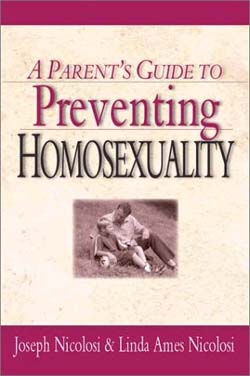 Many gay men become violently angry when exposed to
anti-gay propaganda, such as the new ex-gay book, A
Parent's Guide to Preventing Homosexuality, by
psychologist Joseph Nicolosi, Ph.D. and Linda Ames
Nicolosi. Nicolosi says that gay men's "anger" is due to a
homosexual "developmental disorder," which is preventable
in childhood and treatable in adults. He pooh-poohs the
idea that gay men's anger is understandable, given how
offensive those of his ilk are.
Many gay men become violently angry when exposed to
anti-gay propaganda, such as the new ex-gay book, A
Parent's Guide to Preventing Homosexuality, by
psychologist Joseph Nicolosi, Ph.D. and Linda Ames
Nicolosi. Nicolosi says that gay men's "anger" is due to a
homosexual "developmental disorder," which is preventable
in childhood and treatable in adults. He pooh-poohs the
idea that gay men's anger is understandable, given how
offensive those of his ilk are.
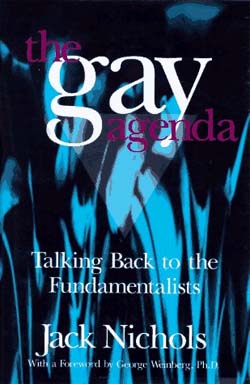 GayToday editor Jack Nichols' book was misrepresented by Joseph Nicolosi to show gays as being anti-family
GayToday editor Jack Nichols' book was misrepresented by Joseph Nicolosi to show gays as being anti-family  This ad for the Easy Bake Oven and the Queasy Bake Oven, here associated with a boy, illustrates the gender branding society accomplishes through the mass media
This ad for the Easy Bake Oven and the Queasy Bake Oven, here associated with a boy, illustrates the gender branding society accomplishes through the mass media 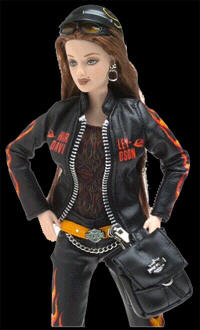 Nicolosi has an obsession with Barbie (like this leather one)
Nicolosi has an obsession with Barbie (like this leather one) 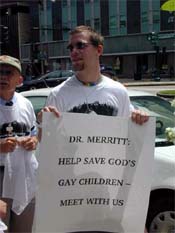 Gay libration groups, like Soul Force seen here protesting in New Orleans, also get slammed in Preventing Homosexuality
Gay libration groups, like Soul Force seen here protesting in New Orleans, also get slammed in Preventing Homosexuality 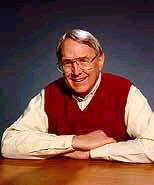 Dr. James Dobson
Dr. James Dobson 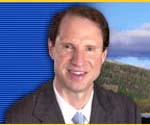 Sen. Wyden: Silent on gay rights
Sen. Wyden: Silent on gay rights